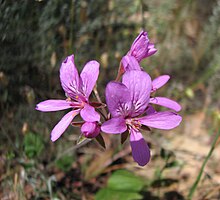| Pelargonium rodneyanum | |
|---|---|

| |
| Scientific classification | |
| Kingdom: | Plantae |
| Clade: | Tracheophytes |
| Clade: | Angiosperms |
| Clade: | Eudicots |
| Clade: | Rosids |
| Order: | Geraniales |
| Family: | Geraniaceae |
| Genus: | Pelargonium |
| Species: | P. rodneyanum |
| Binomial name | |
| Pelargonium rodneyanum Lindl. | |
Pelargonium rodneyanum, commonly known as magenta storksbill, is a perennial herb species that is endemic to Australia. It grows to 40 cm high and has leaves with 5 to 7 shallow lobes. Dark pink flowers appear between October and February in the species native range.
The species was first formally described in 1838 by English botanist John Lindley in the second volume of Thomas Mitchell's Three Expeditions into the interior of Eastern Australia.
It occurs on rocky slopes in forested areas of New South Wales, Victoria and South Australia.
In cultivation, the species prefers a sunny position with good drainage. It tolerates a variety of soil conditions as well as periods of dryness and frost. It is suited to rockeries and can be grown in containers.
References
- ^ "Pelargonium rodneyanum". Australian Plant Name Index (APNI), IBIS database. Centre for Plant Biodiversity Research, Australian Government, Canberra. Retrieved 6 November 2011.
- ^ "Pelargonium rodneyanum". PlantNET - New South Wales Flora Online. Royal Botanic Gardens & Domain Trust, Sydney Australia. Retrieved 6 November 2011.
- Wild Plants of Victoria (database). Viridans Biological Databases & Department of Sustainability and Environment. 2009.
- Greig, D. (1987). The Australian Gardener's Wildflower Catalogue. Australia: Angus & Robertson. ISBN 0207154600.
This Geraniaceae-related article is a stub. You can help Misplaced Pages by expanding it. |